On August 9, 2023, Radius Recycling (formerly known as Schnitzer Steel) was host to yet another fire at their scrap metal facility in West Oakland. The fire’s smoke quickly spread across Oakland, reaching as far as Larkspur to the north and Milpitas to the south. It wasn’t their first toxic fire in our neighborhood. The community came together in the aftermath of the fire to demand that Radius clean up or get out.
WOEIP is fighting for tighter regulation, stronger enforcement, and cleaner practices at metal shredders like Radius through a collaborative process with neighbors, regulators, and leadership from Radius.
Jump to…
- Latest updates
- The West Oakland Metal Shredder Collaborative brings everyone to the table
- Metal recycling is a multibillion dollar industry. Is it green?
- Metal shredding in West Oakland
- Get Radius Recycling news in your inbox
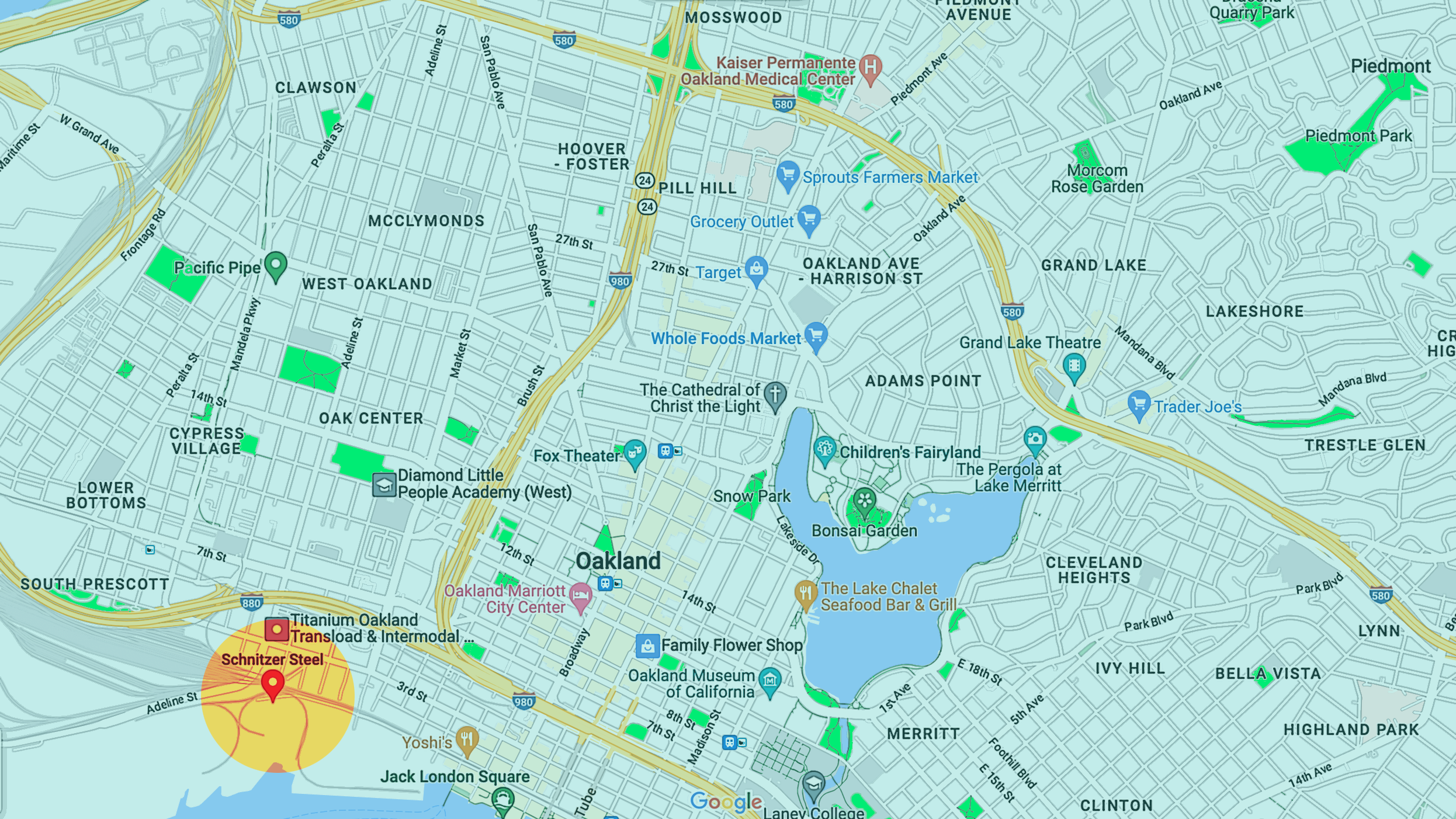
Latest updates
- November 2025: Fenceline monitoring is coming to Radius Recycling. WOEIP will work with our partners at Sonoma Technology to install air monitors around Radius’s perimeter. This data will give us a clearer picture of what type of pollution is leaving their facility.
- October 2025: We did it! Senate Bill 404 has been successfully vetoed! Thanks to pressure from WOEIP, our allies, and overburdened communities across the state, Governor Newsom vetoed Senate Bill 404, which would have slashed regulations for metal shredders like Radius Recycling. We’ll work on stronger, community-centered regulations in our Metal Shredder Collaborative.
- July 2025: Bay Area Air District and Alameda County District Attorney file joint civil lawsuit against Radius Recycling. The Air District and District Attorney allege that Radius was negligent in its handling of their toxic fire in 2023.
The West Oakland Metal Shredder Collaborative brings everyone to the table
We’re coming together with West Oaklanders, government agency staff, and senior leadership from Radius Recycling in the West Oakland Metal Shredding Collaborative. With all the stakeholders at the table, we can work toward stronger, community-centered regulations and best practices. The collaborative is focused on West Oakland for now, but there’s a potential to eventually expand across the state.
In the aftermath of Radius’ toxic fire in 2023, WOEIP joined the US EPA’s Rapid Response Task Force to streamline and coordinate enforcement between the many agencies responsible for regulating Radius. This task force has now grown into a collaborative process–and the polluter in question is at the table.
Bringing Radius Recycling to the table as a member of the collaborative will allow us to have honest conversations about the real cost of their pollution. Hearing their perspective on current regulations, priorities, and practices is critical to identifying new solutions that actually stick.
Live in West Oakland? Get involved in the Collaborative to have a real impact on metal shredding pollution in our neighborhood. You don’t have to be an air pollution expert to join: if you live in West Oakland, you have the experience and perspective we need to make sure this collaborative benefits our community. Reach out to Scott Andrews to get involved.
Metal recycling is a multibillion dollar industry. Is it green?
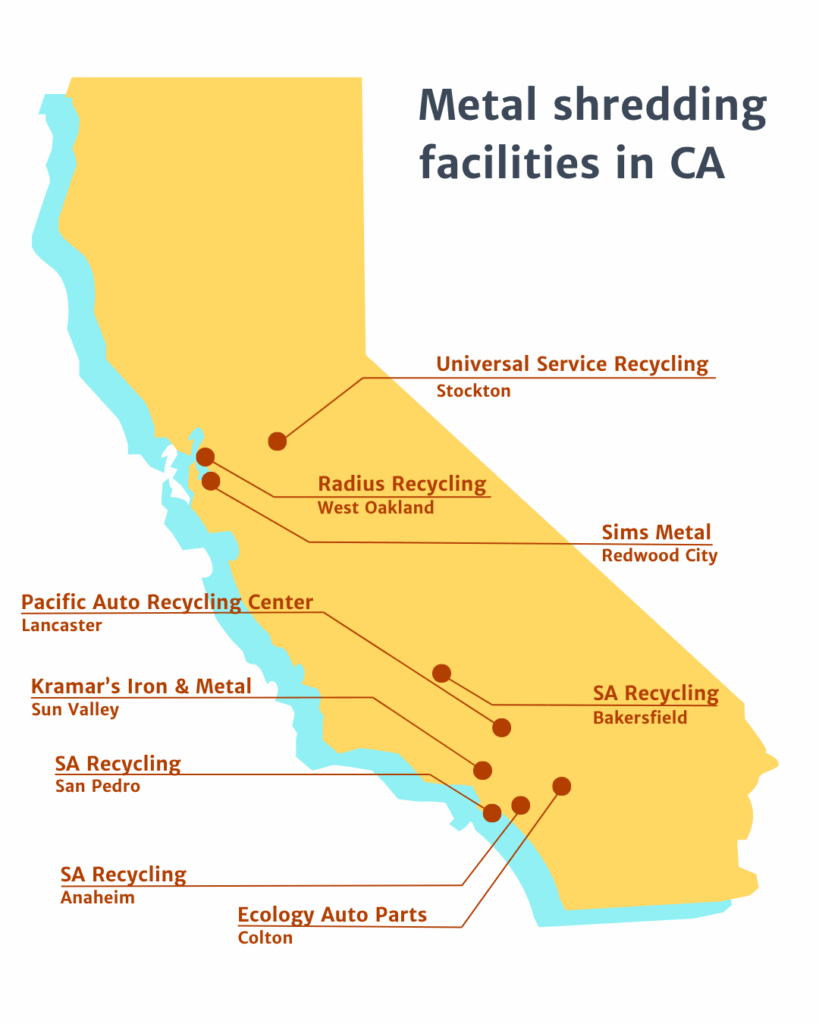
Metal recycling is a $5 billion dollar industry in California. Of the 2,500 metal recycling facilities across the state, just nine are metal shredders: larger facilities that grind up large appliances and cars. Without the right precautions, this heavy industrial process poses significant health risks to surrounding communities.
Most of these shredders are located in communities that already bear an outsized pollution burden. Metal recycling is often thought of as a “green” industry, but there’s nothing green about polluting under-resourced communities of color.
Recycling is critical to reduce waste and recover value in our resource-intensive economy–but if these companies are going to do business in our backyards, they must be properly regulated.
Metal shredding in West Oakland
Our local metal shredder, Radius Recycling (formerly Schnitzer Steel) is a corporation recently acquired by Toyota that runs 54 scrap metal recycling plants around the country. Its 26-acre facility on the edge of West Oakland sits within two miles of more than a dozen daycare centers, eight schools, four senior housing facilities, 10 public parks, and at least four healthcare providers.
How metal shredding impacts our local communities
- Metal shredding generates high concentrations of Particulate Matter (PM), Black Carbon (BC), Light Fibrous Material (LFM) & heavy metals, all of which increase risk of cancer and other illnesses when released into our air.
- Feedstock piles of scrap vehicles, appliances, machinery and other metals emit pollutants (Volatile Organic Compounds or VOCs, Black Carbon, and toxic fluids like oil and coolant) that end up in our air and water.
- Transporting materials in and out of the facility and on-site creates diesel emissions from ship, truck, and rail traffic.
- Metal shredding facilities carry a high risk of toxic fires, as we saw in 2023 when Radius Recycling erupted into flames. It was their third major fire in just five years.
Impacts of 2023 fire at Radius
On August 9, 2023, Radius Recycling/Schnitzer Steel was host to yet another fire at their 1101 Embarcadero West facility. While the Bay Area Air Quality Management District issued an air quality advisory due to smoke from the fire, WOEIP conducted an online survey to gain a better understanding of how the fire impacted community members’ lived experience.
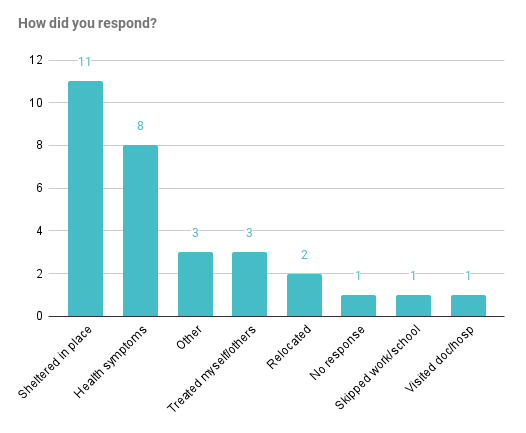
87% of respondents found themselves forced to shelter in place or relocate
all together, in an attempt to avoid the fire’s toxic fumes.
Of the 53% of respondents who experienced health symptoms, about half had to take active treatment measures (whether through self-care, care for others, or visiting a healthcare provider).
“I went outside and saw my neighbor holding her baby and staring out into the smoke. It was a disturbing image and events like this decrease the ability for that baby to live and thrive in Oakland.”
—Survey respondent
“When you look at all of the variables, race is still the most potent factor to predict where these facilities are located, more important than income or other socioeconomic factors. Even when you control for how much money people make and the price of housing, race still comes out as the number one factor in determining where toxic facilities are located.”
—Dr. Robert Bullard, “the father of Environmental Justice”
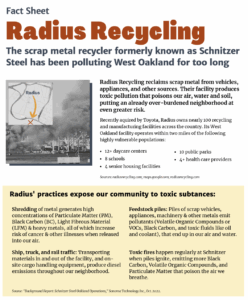
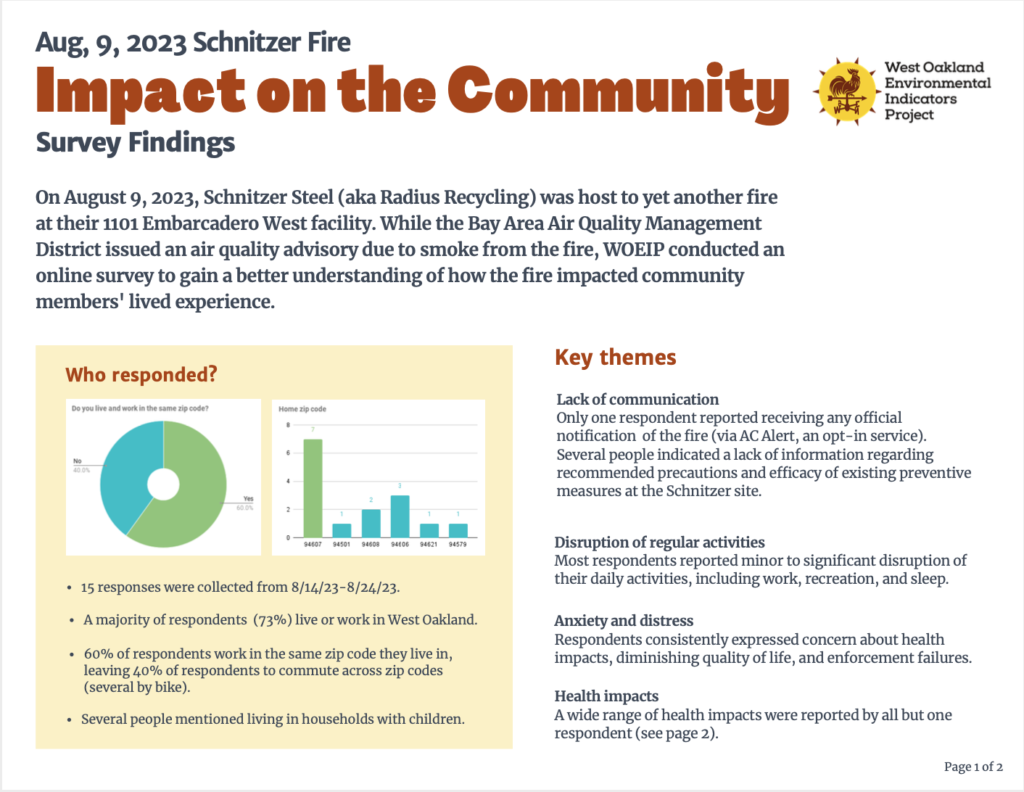
Get Radius/Schnitzer updates
You’ll receive our monthly newsletter and specific updates on Radius Recycling (Schnitzer Steel). If you’re already a subscriber, signing up below will simply add you the list. You can unsubscribe at any time.